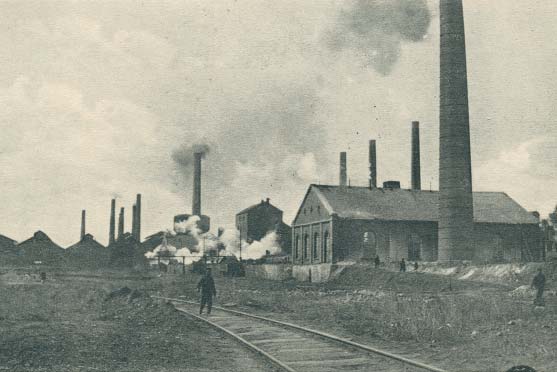The first Belgian enterprises appeared in the territory of Ukraine in the 1880s, and these were horsedrawn trams in Odesa (1880) and Kharkiv (1883). And in total, 7 Belgian companies, which worked in the tramway business, started their activity in the Empire in 1894.
The rapid growth of Belgian companies took place in 1895–1901, when their number increased to 117. In 1901, the Belgians occupied the first place in the number of foreign companies operating in the Empire (the total number was 209). Out of the 117 Belgian companies, 60 were operating in Ukraine, others in the Empire (without Ukraine). Also, after 1890, the total amount of Belgian investment in Ukraine at least equaled (and sometimes significantly exceeded) all the investments into the vast Russian Empire.

In 1900, Belgium was the first and largest foreign investor in the Empire with an investment volume of 831 million gold francs. It was followed by France (692 million), Germany (162 million) and Great Britain (236 million). That is, the very small Kingdom of Belgium gave 41% of all investments of the “Big Four”. Belgian investments reached the most distant corners of the huge Empire. But their interest was concentrated in the Prydniprovsky-Donetsk region in Ukraine, where they made a huge contribution to modernizing the economy and developing the region that is now South-Eastern Ukraine (former Katerynoslav Governorate).
There were 48 Belgian joint stock companies in Katerynoslav Governorate. The largest of the companies was the gigantic South-Russian Dnipro Metallurgical Society. Created by two powerful industrial corporations — the Lilpop, Rau and Loevenstein, situated in Poland, and the John Cockerill Company, situated in Seraing, Belgium. These are also the association of the Russian Chaudoir pipe-rolling factories, which built three factories in Katerynoslav, the Russian-Belgian Metallurgical Society (Yenakiieve city) and also “Liubimov and К0” Joint Stock Company in soda production, and others.
The scope of distribution of Belgian companies in the Ukrainian economy was broad, but the most important objects of their activities were ore mining and smelting, metal-processing and machine-building industry, coal mining and coke production, as well as urban transport and construction. The share of these industries accounted for more than 70% of the share capital of Belgian companies. In urban transport, construction and glass, as well as in the chemical industry, they were monopolists. And this is not by accident. At that time, Belgium was the foremost economic and industrial state of Europe, ranked first in the density of railways and second in coal mining, steel and iron production.
“Worthy of astonishment, with what persistent perseverance, with what understanding of all the importance of the correctness of the calculation of what the preparation costs will become at any kind of fabrication, every Belgian systematically finds new affairs,” wrote the Belgian engineer, I. Izar, at that time.
It was the search for new business that brought Belgian entrepreneurs to Ukraine, where the discovery of significant coal and iron strata promised significant profits and the rapid development of industry. In search of new affairs, the Belgians headed eastward, to Ukraine.
“… Foreigners are going to Russia with huge capital! The Belgians are already the main hosts in the South of Russia. The only conversations have been heard recently, particularly pressing hard on the Belgians, pointing out that the best mines and iron works are in their hands throughout the Dnipro region. On the train you can only hear: ore, coal, pitting, prospecting, the Belgians …” — the well-known journalist, Volodymyr Giliarovsky, wrote in the “Iron Fever” article during the visit to Katerynoslav region in 1899.
The documentary evidence of this story is the museum collection of securities donated by the museum patron Dmytro Pirkl in the amount of 210 items. 110 shares and bonds of which are of the Belgian Societies — mining and metallurgical, machine building, mechanical, producing metal products, construction, chemical, glass and ceramic materials, urban transport (trams). Brussels, Marchienne au Pont, Liege, Sale, Zhulii, Couvin, La Louviere (Wallonia) were the location of the Administrations and the cities of the creation of joint stock companies and the registration of the Statutes. Among the founders of the Belgian societies were so called “industrialists” — directors of industrial or transport companies, engineers who had already got their industrial companies in Belgium — Cockerill, Solvay, Lamber and others. In 1897, 576 Belgian citizens worked in the Governorate. These were engineers, craftsmen, managers and skilled workers, members of their families, doctors and teachers. After 1897, the number of Belgian subjects in the Empire was increasing by 2000 annually.
The Belgian consulates acted in Katerynoslav (General), Kharkiv, Berdiansk, Kyiv, Mykolaiv, Odessa, Mariupol and Sevastopol. Professional diplomats worked there. Katerynoslav region was called “Russian Belgium”. Donetsk Basin — “The Tenth Belgian Province”, and Katerynoslav and Mariupol — “Window to Europe”.
Geography of Ukrainian enterprises is the most diverse. These are Katerynoslav (Dnipro), Kamianske, Kryvy Rih, Verkhniodneprovsk, Luhansk, Yenakiieve, Mariupol, Uspensk, Konstiantynivka, Horlivka, Debaltsevo, Torez, Kramatorsk and others. Many enterprises, which were established in the 1880s–1890s, have been operating in Ukraine until today.
Valentyna Lazebnyk, Head of History of Ukraine of XIV-early XX Centuries Department of the Dnipropetrovsk National Historical Museum named after D.I. Yavornytsky













